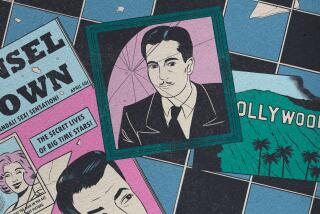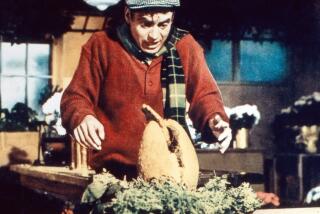Celebrating Cukor
- Share via
At a private memorial gathering, writer Fay Kanin, then president of the Academy of Motion Picture Arts and Sciences, stood before a Hollywood crowd and observed with a smile: “George Cukor had so many friends, I wonder how he found the time to make all those wonderful movies.”
That was in February 1983, after Cukor died of a heart attack at 83. Certainly, a gift for friendship characterized Cukor as much as his talent for directing movies of enduring wit and charm over a film career that spanned more than half a century.
Cukor had long won the respect and affection of those in the industry; late in life, Henry Hathaway, that most colorful and macho of directors, spoke movingly of Cukor’s devotion to Hollywood and its institutions. “You might say that while the rest of us married and had children, George had married Hollywood.” (On the set Cukor’s No. 1 rule was, “Never try to fool your crew.”)
The academy, along with the Los Angeles County Museum of Art, the Directors Guild of America and the Hungarian Film Commission--Cukor was of Hungarian-Jewish ancestry--is sponsoring a 32-film retrospective marking the centennial of Cukor’s birth. The celebration begins Thursday at the academy as Kanin joins art director Gene Allen, writer Gavin Lambert, and directors Paul Mazursky and Istvan Szabo in a panel discussion about Cukor moderated by film historian and Time magazine film critic Richard Schickel. This follows an 8 p.m. screening of clips from Cukor films and his scintillating 1932 film “What Price Hollywood?,” which would be remade as “A Star Is Born,” first by William Wellman and then by Cukor himself.
On the screen Cukor was able to bring alive with unpretentious grace the worlds of romance, drama and comedy. His films were set in the past as well as the present and spanned all strata of society and include such classics as “The Women,” “The Philadelphia Story,” “Camille,” “My Fair Lady” and “Adam’s Rib,” among many others.
Cukor adored many women, empathized with them, yet he understandably hated being tagged “a women’s director” because it overlooked his considerable skill with actors. He drew splendid performances from such varied male leads as John Barrymore, Cary Grant, James Stewart, Spencer Tracy, Anthony Quinn, Rex Harrison and Jack Lemmon.
Typically, Cukor’s movies were inhabited with charismatic stars, and he viewed the challenges facing the characters they played so effectively under his subtle direction with a bemused yet compassionate detachment. Arguing that Cukor’s theme was imagination, “with the focus on the imaginer rather than the thing imagined,” critic Andrew Sarris concluded that Cukor “was committed to the dreamer, if not the content of the dream.”
A discreet homosexual, Cukor was an inspiration to generations of gays in the film industry. Cukor was at ease about his own sexuality, but he never felt comfortable in coming out publicly. This ultimately blocked his repeated attempts to write a memoir, even though he was fully aware that once he was gone it would be much written about. He hated the term “gay,” feeling it too frivolous-sounding, and late in life said, “I know I should come out, but I’m just too old.”
Dialogue Director on ‘All Quiet’
When he arrived in Hollywood 70 years ago as a dialogue director on “All Quiet on the Western Front,” he had already befriended such literary lights as Somerset Maugham. Yet he quickly became great pals with such hearty, ethnic comedians as Polly Moran and Fanny Brice. Most important, especially for the eras he spanned, Cukor became a mentor for at least three generations of gay men at various levels in the motion picture industry. Cukor believed strongly in knowing your worth, standing up for yourself and never, never indulging in self-pity--no matter who or what you were or your circumstances.
If he did not make a public declaration of his homosexuality, he never pretended to be other than what he was, and surely within the film industry and, for that matter, well beyond it, his sexual orientation was as well known as that of Rock Hudson. Public identification as a homosexual, especially in regard to celebrities, has often been--and still is--a matter of degree rather than the either-or situation of being in the closet or out of it.
However, there’s a current tendency to take an “outer than thou” view of gays in Hollywood’s past. William Mann, who wrote “Wisecracker,” an excellent recent biography of William Haines, silent star turned leading interior decorator (who in fact decorated Cukor’s elegant West Hollywood hills home), admitted that his publisher had stretched a point in proclaiming Haines, on his book’s dust jacket, “Hollywood’s first openly gay star,” even though the actor decided to put a longtime relationship ahead of his screen career.
Cukor’s friends were stung by his depiction in the otherwise delightful “Gods and Monsters,” which set up Cukor as a closeted gay in contrast to director James Whale’s openness; in fact Cukor has been said to have remarked that Whale was “too indiscreet.”
It should be pointed out that by the time of Whale’s suicide in 1957, the gifted director of “Frankenstein,” “Bride of Frankenstein” and “Show Boat” had been retired for years, his career not derailed by his homosexuality but professional setbacks and, above all, by the loss of his mentor at Universal, Carl Laemmle Jr.
At that time Cukor was still at the height of his career, which would last another 24 years, and it should be obvious that in that conservative era it would have been professional suicide for him or any other Hollywood gay or lesbian to make a public declaration of sexual orientation. (Interestingly, director Curtis Harrington, who befriended Whale in his last years and coached Ian McKellen in his role as Whale, admitted he did not recall Whale ever mentioning Cukor, favorably or otherwise.)
More amusingly, “Gods and Monsters” depicted Cukor briefly as the host of an elaborate garden party in honor of a heavily caricatured Princess Margaret. Cukor is shown to look askance at Whale for having brought along his hunky gardener, played by Brendan Fraser. What actually would have most concerned Cukor is that Whale would have been so thoughtless as not to have taken care to have his friend dress formally for the occasion and therefore be more at ease in his surroundings.
An Affection for Bluebloods
Cukor in fact was acquainted with Princess Margaret, and once when he received an invitation to a reception at Pickfair in her honor he did not disguise his joy; he loved high society. He was genuinely puzzled to discover when he visited St. Petersburg’s vast palaces in the mid-’70s--he was in Russia to make “The Blue Bird”--that guides there had no interest whatsoever in their last noble inhabitants, a number of whom were his friends. And one of Cukor’s best friends was the irrepressible Whitney Warren Jr., son of one of the architects of Grand Central Station, an American blueblood who, on his mother’s side, was of such noble lineage that he was the house guest of the Queen Mother at the time of the wedding of Princess Diana and Prince Charles.
Yet it would be shortsighted to write off Cukor as a mere snob when in fact his friends ranged from living legends to the forgotten and impoverished, the young and old, straight and gay, male and female. A male hustler, as long as he could hold up his end of the conversation, might be invited to dine at the same table with an authentic baron.
Cukor was not universally liked; he was too mercurial for that. He had a hair-trigger temper, could swear like the proverbial stevedore, suffered fools for not so much as a nanosecond, and tended to make snap judgments about individuals and situations that were not always on the mark. If he didn’t like you, he didn’t like you and that was that.
But if he did like you, as Katharine Hepburn, with whom he had a legendary professional and personal relationship that spanned half a century, put it: “If George was your friend, he really was your friend.” As volatile--and very funny, too--as he could be, he could also be exceedingly subtle and understated in nudging you in what he thought was the best direction.
To the end of his life, Cukor loved to entertain, although on a less and less grand scale. Once he invited Mae West to a party in honor of Greta Garbo, whom Cukor had brought to the height of her career with “Camille,” in which she played the gallantly dying courtesan Marguerite Gautier. Garbo was said to have been amused by a solicitous West, who was concerned that the reclusive star not be standing in a draft; afterward, West, giving the lowdown on this meeting of titans, remarked, in what for her was the greatest of compliments: “She could work, if she wanted to.”
Cukor loved to have three or four friends over for dinner almost every night when he wasn’t working. There would be impromptu gatherings for such visiting friends as Mia Farrow, who was his goddaughter, and for Rachel Roberts, whom Cukor came to know when he was directing her then-husband Rex Harrison in “My Fair Lady.”
An Oscar for ‘My Fair Lady’
The 1964 film version of the celebrated Broadway musical would bring Cukor a long overdue Oscar. In the years following, Cukor would find it increasingly difficult to get projects off the ground and would make himself available to replace a director departing over the familiar artistic differences. He soldiered on--this after all was the man who did not let being fired from “Gone With the Wind” defeat him. He turned to television, where he would be reunited with Hepburn, who was teamed with Laurence Olivier, in “Love Among the Ruins,” which could stand with his best work and was showered with Emmys and much acclaim.
He teamed with Hepburn a final time, traveling to Wales to make a fine TV version of “The Corn Is Green.” When Cukor watched it on the TV in his library, the first call he received, once it was over, was from an enthusiastic Irving Berlin, who could be heard across the room and made Cukor promise to pass on his congratulations to Hepburn.
On the last evening of his life, Cukor dined, as usual, with old friends and, when stricken later that night, mercifully died within an hour of his arrival at Cedars-Sinai Medical Center. Earlier in the day, his gentlemanly agent, the late Ben Benjamin, called him with a firm offer to make a documentary on his most celebrated actresses, which meant that Cukor was in the game to his last breath.
Accolades poured in from around the world, but his funeral at Forest Lawn was a private, intimate occasion. Stage and screen legend Ina Claire, vivacious and glamorous at 90, and Warren came down from San Francisco. From “All Quiet on the Western Front” were William Bakewell and Lew Ayres, whom Cukor would direct in a memorable performance as Hepburn’s alcoholic brother in “Holiday.” Sammy Colt, Ethel Barrymore’s affable son, was also among those present to see Cukor laid to rest next to Frances and Samuel Goldwyn; it was Cukor who had urged the beautiful Broadway ingenue Frances Howard to marry the Hollywood pioneer.
If afterward you lingered beside your car, you could observe those last to leave, Irene Burns, Cukor’s lovely, devoted secretary since 1947, and his cook and chauffeur, a married couple who were also loyal retainers. They made their way across a grassy slope to Cukor’s big, old black Rolls-Royce, and slowly got in. And then they were gone.
*
* “The George Cukor Centennial Retrospective” is Thursday-Aug. 21 at LACMA. (323) 857-6010.
More to Read
Only good movies
Get the Indie Focus newsletter, Mark Olsen's weekly guide to the world of cinema.
You may occasionally receive promotional content from the Los Angeles Times.










